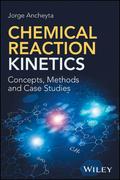Chemical Reaction Kinetics
Concepts, Methods and Case Studies

1. Edition August 2017
304 Pages, Hardcover
Wiley & Sons Ltd
A practical approach to chemical reaction kinetics--from basic concepts to laboratory methods--featuring numerous real-world examples and case studies
This book focuses on fundamental aspects of reaction kinetics with an emphasis on mathematical methods for analyzing experimental data and interpreting results. It describes basic concepts of reaction kinetics, parameters for measuring the progress of chemical reactions, variables that affect reaction rates, and ideal reactor performance. Mathematical methods for determining reaction kinetic parameters are described in detail with the help of real-world examples and fully-worked step-by-step solutions. Both analytical and numerical solutions are exemplified.
The book begins with an introduction to the basic concepts of stoichiometry, thermodynamics, and chemical kinetics. This is followed by chapters featuring in-depth discussions of reaction kinetics; methods for studying irreversible reactions with one, two and three components; reversible reactions; and complex reactions. In the concluding chapters the author addresses reaction mechanisms, enzymatic reactions, data reconciliation, parameters, and examples of industrial reaction kinetics. Throughout the book industrial case studies are presented with step-by-step solutions, and further problems are provided at the end of each chapter.
* Takes a practical approach to chemical reaction kinetics basic concepts and methods
* Features numerous illustrative case studies based on the author's extensive experience in the industry
* Provides essential information for chemical and process engineers, catalysis researchers, and professionals involved in developing kinetic models
* Functions as a student textbook on the basic principles of chemical kinetics for homogeneous catalysis
* Describes mathematical methods to determine reaction kinetic parameters with the help of industrial case studies, examples, and step-by-step solutions
Chemical Reaction Kinetics is a valuable working resource for academic researchers, scientists, engineers, and catalyst manufacturers interested in kinetic modeling, parameter estimation, catalyst evaluation, process development, reactor modeling, and process simulation. It is also an ideal textbook for undergraduate and graduate-level courses in chemical kinetics, homogeneous catalysis, chemical reaction engineering, and petrochemical engineering, biotechnology.
Chapter 1. Fundamentals of chemical reaction kinetics
1.1. Concepts of stoichiometry
1.1.1. Stoichiometric number and coefficient
1.1.2. Molecularity
1.1.3. Reaction extent
1.1.4. Molar conversion
1.1.5. Types of feed composition in a chemical reaction
1.1.6. Limiting reactant
1.1.7. Molar balance in a chemical reaction
1.1.8. Relationship between conversion and physical properties of the reacting system
1.2. Reacting systems
1.2.1. Mole fraction, weight fraction and molar concentration
1.2.2. Partial pressure
1.2.3. Isothermal systems at constant density
1.2.4. Isothermal systems at variable density
1.2.5. General case of reacting systems
1.2.6. Kinetic point of view of the chemical equilibrium
1.3. Concepts of chemical kinetics
1.3.1. Rate of homogeneous reactions
1.3.2. Power law
1.3.3. Elemental and non-elemental reactions
1.3.4. Comments on the concepts of molecularity and reaction order
1.3.5. Dependency of k with temperature
1.4. Description of ideal reactors
1.4.1. Batch reactor
1.4.2. Continuous reactors
Chapter 2. Irreversible reactions of one component
2.1. Integral method
2.1.1. Reactions of zero order
2.1.2. Reactions of first order
2.1.3. Reaction of second order
2.1.4. Reactions of nth order
2.2. Differential method
2.2.1. Numerical differentiation
2.2.2. Graphical differentiation
2.3. Method of total pressure
2.3.1. Reactions of zero order
2.3.2. Reactions of first order
2.3.3. Reactions of second order
2.3.4. Reactions of nth order
2.3.5. Differential method with data of total pressure
2.4. Method of the half-life time
2.4.1. Reactions of zero order
2.4.2. Reactions of first order
2.4.3. Reaction of second order
2.4.4. Reaction of nth order
2.4.5. Direct method to calculate k and n with data of t1/2
2.4.6. Extension of the method of half-life time (t1/2) to any fractional life time (t1/m)
2.4.7. Calculation of activation energy with data of half-life time
2.4.8. Some observations of the method of half-life time
Chapter 3. Irreversible reactions with two or three components
3.1. Irreversible reactions with two components
3.1.1. Integral method
3.1.2. Differential method
3.1.3. Method of initial reaction rates
3.2. Irreversible reactions between three components
Chapter 4. Reversible reactions
4.1. Reversible reactions of first order
4.2. Reversible reactions of second order
4.3. Reversible reactions with combined orders
Chapter 5. Complex reactions
5.1. Yield and selectivity
5.2. Simultaneous or parallel irreversible reactions
5.2.1. Simultaneous reactions with the same order
5.2.2. Simultaneous reactions with combined orders
5.3. Consecutive or in series irreversible reactions
5.3.1. Consecutive reactions with the same order
5.3.2. Consecutive reactions with combined orders
Chapter 6. Special topics in kinetic modeling
6.1. Data reconciliation
6.1.1. Data reconciliation method
6.1.2. Results and discussion
6.1.3. Conclusions
6.2. Methodology for sensitivity analysis of parameters
6.2.1. Description of the method
6.2.2. Results and discussion
6.2.3. Conclusions
6.3. Methods for determining rate coefficients in enzymatic catalyzed reactions
6.3.1. The model of Michaelis-Menten
6.3.2. Methods to determine the rate coefficients of the Michaelis-Menten equation
6.3.3. Application of the methods
6.3.4. Discussion of results
6.3.5. Conclusions
6.4. A simple method for estimating gasoline, gas and coke yields in FCC processes
6.4.1. Introduction
6.4.2. Methodology
6.4.3. Results and discussion
6.4.4 Conclusions
6.5. Estimation of activation energies during hydrodesulfurization of middle distillates
6.5.1. Introduction
6.5.2. Experimental
6.5.3. Results and discussion
6.5.4. Conclusions
Problems
References
Nomenclature


